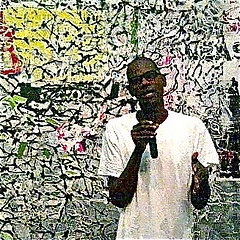Would you take business advice from an artist dressed in jeans and a white t-shirt? You would if that artist takes found objects and turns them into large-scale, abstract paintings that sell for $200,000. Why so much? Because this is the story about the people, places and things involved in this artwork. Any sales professional could learn from Mark Bradford.Bradford opened a show at the Chicago Museum of contemporary art with a walking tour and gallery talk this past holiday weekend. This artist found the freedom to tell stories with abstract art, and not the usual paint splotches, but with actual elements from the community interwoven into each piece. He wanted to reinvent abstraction – to make space for a new conversation. He wanted to infuse abstraction with a new narrative, one reflective of a social vocabulary that pointed away from traditional abstraction.
The power of his visual ideas and his process is a form of art making. Day-to-day work practice bleeds into his creative process. He told the story of working in his mother’s salon doing a “Gerry curl” perm and spotting an “end paper” on the floor (the two-by-two inch paper square used to roll curls) and how translucent it was and cheap (50 cents a box) and how that could be transformed. Having little money at the time, he bought a white sheet from the thrift store and used them. That was the beginning of taking everyday mediums and printed items from the community he lived and worked in to communicate his social narrative.
He drives around south central L.A. in a truck collecting and tearing down content with various tools pretending to be a city worker (dressed in a reflective vest and setting out orange cones). You won’t see a Wal-mart branded item in his work, but you will see local posters and advertisements found throughout his neighborhood.
His background is in the service industry. He is fascinated with micro-businesses and economies and the running narrative of those who live and work there. He focuses on people who, because of social and economic reasons, cannot leave, but are targeted by ads for payday loans and DNA testing. He is fascinated by how we negotiate life and the vulnerabilities in a particular environment.
Throughout his talk, I gained a much better understanding of the rapid deployment of ads in our community. When one ad is pasted on top of another, you can get layers of posters and billboards that resemble plywood. As he finds these, he has to take them to his studio and soak in water to separate all the messages. Then, he begins intertwining these themes with his artwork.
When asked what he has learned from this process. He answered that he has, “Learned to step away and evaluate from a distance. Just as you would in an argument, where stepping away allows you to cool down and explore the possibilities.”
The tour wrapped up in a three-story atrium with us standing in front of a plywood boat that filled the room and was covered in layers of images similar to his smaller pieces. As Bradford began to tell the story of this piece, he described a trip to New Orleans to partner with a charity to help rebuild the Ninth Ward. He was describing the politically charged environment and he searched to learn how he could contribute. It was obvious that a donated piece of art would help, so it went up for auction and soon he had helped raise $200k from that single sale to donate for rebuilding efforts.
As he spent time in New Orleans and got to know the people, he wanted to develop a message of what was to come. That is when the idea of an ark came together. It was a container of life, of possibility, that holds the best of the past and will evolve into the future.
He told of often people have assumed the boat is built from found wood in the Ninth Ward. But, he assured us that would have just been insensitive to gather pieces of these washed away homes and use for his art. It was all wood he already had in is studio in LA.
I had walked by this mammoth boat a couple times before the tour began and did not even stop to read the description of this piece. I was sold with a story and was inspired to retell the story. Bradford tells stories that help people connect with his product and pay top dollar. Do your stories do this for your customers?
Keep up-to-date with Fast Track Tools by subscribing to our blog, via Twitter @fasttracktools and join our Facebook community!
